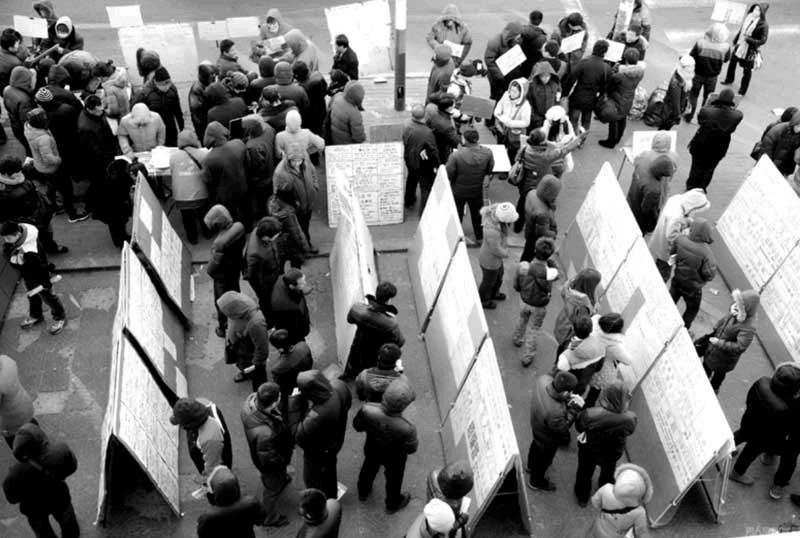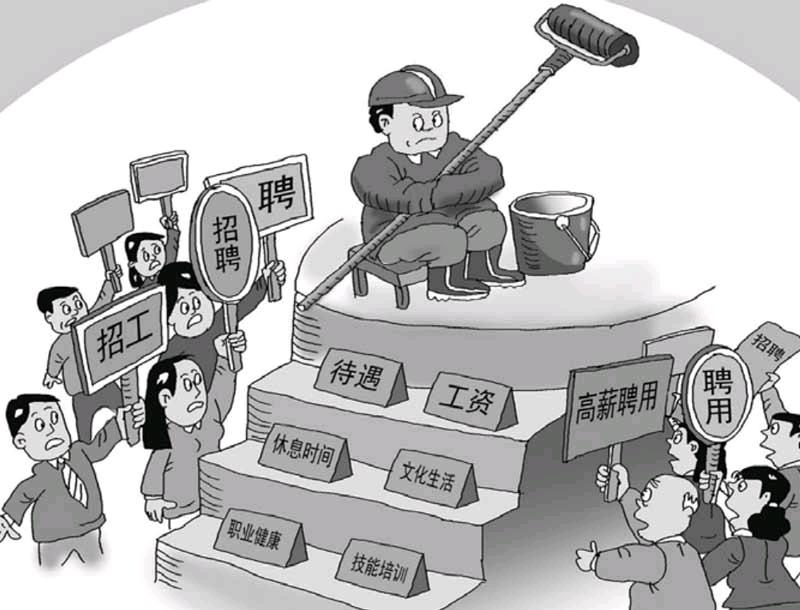China’s Rising Labor Shortages Affects Economic Transition
2017-01-10
Dwindling pool of blue-collar workers is hurting manufacturing, but more college graduates lack skills to support move to service economy
Chinas labor force is expected to drop to 906 million workers in 2016, pushing up labor costs and prompting firms to relocate outside the mainland, a leading demographer said.
The countrys working-age population between the ages of 16 and 59 has declined for three straight years since 2012, said Zeng Xiangquan, head of the China Institute for Employment Research at Renmin University, at a seminar.
This downward trend will continue, with the countrys workforce shrinking to about 700 million people by 2050, Li Zhong, spokesperson for the Ministry of Human Resources and Social Security, said.
Rising labor shortages have pushed up salaries, forcing manufacturers to relocate to Southeast Asia as factories in China are struggling to recruit new workers, Zeng said.
One-child Policy Leds to a Drop in Young Worker
The one-child policy, which led to a drop in birthrates, has led to a decline in the number of young people entering the workforce. But the pool of semi-skilled blue-collar workers, which was once plentiful, is drying up as more young people opt for a college education and prefer to work in the service sectors.
Nearly half the new entrants in the Chinese job market have a college degree, but there is a mismatch between their skills and what the market needs, said Zhang Juwei, director of the Institute of Population and Labor Economics of the Chinese Academy of Social Sciences, at the same seminar.
Zhang said Chinas education system needs to offer better vocational training and teach practical skills to youth.
Although the country is expected to shed 1.8 million workers to trim overcapacity in coal and steel this year, these workers cannot be easily absorbed into the manufacturing sector because they had only nine years of schooling on average.
Experts said labor shortages could hamper Chinas transition from a manufacturing economy to a service- and consumption-driven one.
Labor Costs to Rise by nearly 9%
Labor costs in China are expected to rise by nearly 9% this year, a research report showed, in a development expected to pressure authorities to reduce corporate social insurance contributions and ease other burdens on companies to help them ride out the growth slowdown.
Increasing labor and land costs in China have been forcing foreign investors to move their manufacturing out of the country to cheaper locations in Southeast Asia, while putting the squeeze on local companies already struggling with weakening expansion.
Employers across the country are facing an 8.68% increase to 88,532 yuan ($12,890) in hiring expenses, including salary and benefits, per employee this year, the Pudong Innovation Research Institute, a government think tank in Shanghai, predicted in a report released.
"Employment costs of companies will be driven up further because of slower domestic economic growth, rising salaries, changing supply-and-demand relationships in the labor market and improvements to labor laws," it said in the report.
Its forecasts are based on previously announced official figures and calculations based on mathematical models, it said.
The report called on the government to lower corporate contributions to social insurance for employees, which can be as high as 40% of salaries.
"The overly high social insurance contribution rate will contain the development of the majority of domestic smalland medium-sized companies as global growth, particularly in China, decelerates," it said.
State monopoly in some sectors — which usually offer higher pay but often restrict their employment searches to universities and internal recruitment — should be abolished to open up positions to more job seekers and investment to narrow the income gap with other industries, the report said.
The report also advised that any increases to the minimum wage set by provincial governments each year should be slowed to help smaller companies who employ more unskilled workers to bear the rising costs.
Increase in Salaries
The cities that have restricted home purchases are those thaChengdu, capital of Sichuan province in Chinas southwest, is forecast to lead the increase in salaries with a 14.08% surge, as labor-intensive industries move to the countrys lessdeveloped areas, it said.
Wages in western and central cities have been relatively low, but their increases "far outpaced national average levels" in recent years, the report added.
"The fight for talent in second- and third-tier cities is heating up and salaries have continued to increase rapidly as companies in sectors such as high-tech, internet and finance move to inland areas or set up new facilities there," the report said. "Accelerating development and favorable government policies to attract people and investment are encouraging the transfer of industries to the central and western areas."
Labor costs in big cities such as Beijing and Shanghai are also set to increase rapidly, likely exceeding 10%, the report said.
The countrys gross domestic product (GDP) grew by 75.9% from 2008 to 2015 while salaries rose by just 10.6%, both on an inflation-adjusted basis, according to advisory firm Korn Ferry Institute. The pace of growth of both indicators was the highest in the world, but the gap between the two is also the largest.
In China, senior employees, such as IT managers and chief accountants, saw their incomes rise 22% during the seven years covered by the study. But the pay of entry-level employees — such as clerical workers, network analysts, payroll coordinators and production line supervisors —actually fell, by 1.5%.
With countries like China seeing a whopping 75.9% GDP growth since the beginning of the recession, universities and corporations simply cant train people fast enough. This leaves an acute talent shortage and points to the reason skilled employees are seeing steep pay increase.
Chinas much-anticipated tax reforms, which will help reduce wealth gaps, havent made much progress, with the changes not benefiting lower-end workers and married couples enough, and real estate and inheritance taxes still on their way, critics say.
Chinas Comparative Advantages are Shifting
Chinas comparative advantages are now shifting. Low cost has dominated Chinas competition worldwide in the past three decades. This low-cost competition was driven by a combination of multiple factors, including, most importantly, our cheap labour. After three decades of development, however, Chinas demographics and labour market have changed dramatically in terms of demand and supply.
According to Chinas demographic statistics, its labour supply reached its peak in 2012. Since then, labour supply growth has stagnated, despite the fact that China remains a labour-rich country. At the same time, Chinas population is ageing, which has fundamentally shifted supply and demand in the labour market. The number of new entrants into the workforce every year is estimated around 15 million. In 2000, colleges and universities enrolled only 1.08 million students, which means the remaining 14 million might have joined the blue-collar workforce. Today, 7 million senior high school students can go to college every year, excluding those who seek degrees through full-time self-education or adult education. Compared with a dozen years ago, only half are now entering the labour market as blue collars.
This explains why we have seen a new phenomenon on the job market: it is harder for a university graduate to find a secure and decent job. This has created new pressure for government. At the same time, employers suffer from difficulty in recruiting skilled workers and providing fastgrowing salaries, as evidenced by two-digit growth for consecutive years, in the blue-collar job market. The strained supply-demand relationship has also led to some profound changes: companies are now replacing labour with machines to improve their productivity.
The downside resulting from short labour supply is frequent job-hopping, or high turnover of workers in companies. Joint research with the Chinese Ministry of Commerce reveals a blue collar turnover of up to 100%, and in extreme cases 500%, in some manufacturing and trade companies, which means that all shop floor workers will have been replaced at year end. High turnover also cuts both ways. The upside of frequent job-hopping is the exchange of skills, particularly the transfer of know-how, among different companies, which will make mutual learning more efficient. The downside is that worker exposure to a particular job is too short for them to perfect their skills. Companies in this case will be unwilling to invest in skill training, fearing workers will leave after training.
杂志排行
中国经贸聚焦·英文版的其它文章
- China Eyes Yuan Outflows in Battle Against Sinking Currency
- Planned Technological Transformation of Agri cultural Sector Fails to Im press Farmers
- Digital Currency Overturns the World
- Latest Public Official Changes in China
- Exhibitions
- Li Xiaohong Former President of Wuhan University Appointed as Deputy Minister of education
